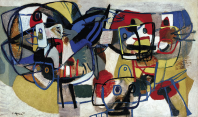Abstract
The Michael Mahzor, produced in Germany in 1258, one of the earliest illuminated Mahzorim, is a two-volume prayer book containing liturgical poems for the Holy Days and the 'four special Sabbaths,' when liturgical additions are made to the regular weekly chapter reading during the month of Adar. The manuscript is copiously illuminated, with animals adorning the opening words of the liturgical poem, and contains a militant iconographical plan, including knights and fighting warriors. The relationship between text and image in illuminated manuscripts is important, because they need to be 'read' together in order to understand the illuminations in their immediate and general context. The novelty of this study is in a holistic reappraisal of the manner in which we think about illustration in connection with text. This paper addresses three scenes containing animals in the Michael Mahzor: El Mitnase, Mich. 617, f. 4v; Zakhor, Mich. 617, f. 11r; and Kol Nidrei, Mich. 627, f. 48r. The first two examples discussed here are the illumination of El Mitnase for Shabbat Shekalim, the Sabbath beginning the month of Adar and the piyyut for the pericope Zakhor for the Shabbath that immediately precedes Purim, which is celebrated on the fourteenth of Adar. The third is the liturgical formula Kol Nidrei for Yom Kippur, the Day of Atonement. The article suggests that the animals in the last two scenes represent the four kingdoms mentioned in chapters seven and eight of the Book of Daniel. Jewish exegesis commonly interpreted these beasts as symbols of four historical kingdoms. In addition, aspects of animal symbolism in the illuminations – such as hunted and hunting animals – should be considered in the context of medieval Jewish-Christian polemics. By examining the scenes together, we can speculate as to the greater plan the patron might have had in mind when ordering this manuscript. The article seeks to understand how the Jewish patrons envisioned themselves and their neighbors, through a prism of images, piyyutim, and the writings of Hasidei Ashkenaz.Except where otherwise noted, the content of this site is licensed under a Creative Commons Attribution-ShareAlike 4.0 International (CC BY-SA 4.0).
Authors retain copyright of their work. The CC BY-SA 4.0 licence allows readers to copy and redistribute the material in any medium or format, and to remix, transform, and build upon the material for any purpose, even commercially, as long as the original author is credited and as long as any works that are derived from the original are distributed under the same terms.

